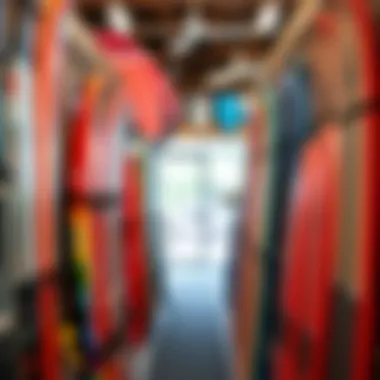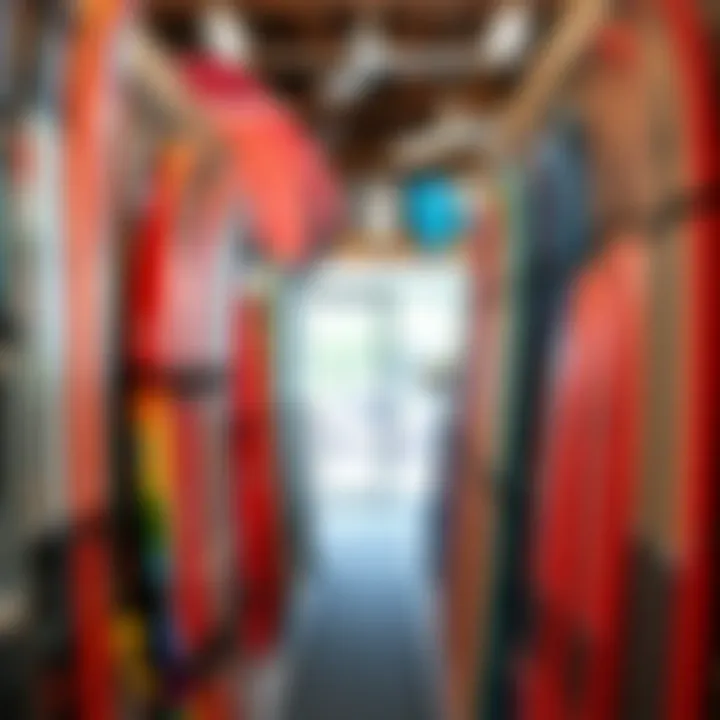Essential Insights into Kiteboard Shops and Services


Intro
Kiteboarding, a sport that blends the thrill of wind, water, and an ever-changing landscape, finds a pivotal anchor in kiteboard shops. These specialized outlets serve as the beating heart of the kiteboarding community, offering not just gear but also a wealth of knowledge and camaraderie. For both novices stepping onto the water for the first time and seasoned riders seeking a fresh perspective, kiteboard shops are invaluable. They bring together a rich assortment of products, expert advice, and an inviting atmosphere that fosters community connections.
Within this guide, we will dive into the essentials of kiteboard shops, examining how their presence shapes the kiteboarding experience. From the latest gear captures to invaluable local expertise, each component discusses how a kiteboard shop serves as a hub for enthusiasts. We will explore trends influencing kiteboarding retail, particularly how they adapt alongside the rise of online shopping. Balancing convenience with the personalized touch that only local businesses can offer is at the crux of our exploration.
Gear Insights
Kiteboard shops are often treasure troves of the latest kiteboarding equipment, showcasing innovations that enhance overall performance and safety. When you're after the right gear, understanding what’s available is crucial.
Latest Gear Reviews
As new products hit the shelves, shops typically provide detailed reviews. Ranging from kites that maximize lift to boards designed for speed and control, customers can expect comprehensive insights.
- Kites: The latest high-aspect ratio designs improve efficiency and handling in various wind conditions.
- Boards: Look for models that employ high-tech materials for a lightweight yet durable feel.
- Harnesses: Offer features such as easy adjustments for comfort and performance.
These reviews help customers make informed decisions about which specific gear aligns best with their skills and riding style.
Essential Gear for Beginners
For those just entering the kiteboarding world, selecting the right equipment can be daunting. A good kiteboard shop will guide beginners through essential purchases:
- Kite: A beginner-friendly kite that’s stable and easy to control is vital. Look for models designed specifically for learning.
- Board: Opt for a slightly larger board which enhances stability and ease of use while practicing.
- Safety Equipment: Helmets and impact vests add a layer of protection that is critical for newcomers learning how to navigate the water.
Understanding the fundamentals of gear selection sets the stage for a safer and more enjoyable kiteboarding experience.
Techniques and Tips
Beyond gear, kiteboard shops frequently host workshops and clinics that focus on improving rider skills and ensuring safety.
Advanced Tricks and Techniques
For those looking to elevate their kiteboarding game, tricks such as the handle pass or the kite loop require detailed instruction and practice. Kiteboard stores often tap into the local pro community, bringing in seasoned riders to share tips. Being part of these sessions not only hones skills but also connects riders with others who share the same passion.
Safety Practices for Kiteboarders
Above all, safety should be a priority on the water. Shops emphasize the importance of adhering to local regulations and environmental factors:
- Practice location awareness: Understanding potential hazards like shallow water or obstructions keeps rides enjoyable.
- Monitor weather conditions: Awareness of changing wind patterns and storm threats is paramount.
- Stay connected with other riders: Sharing information about conditions helps everyone in the community stay safe.
In navigating the intricate world of kiteboard shops, both novices and experienced riders find not only the tools they need but also a community that supports their growth and engagement in the sport. By merging gear insights with practical techniques and safety measures, kiteboard shops resonate deeply with the needs of today’s adventurous spirits.
Prolusion to Kiteboard Shops
Kiteboard shops are more than mere retail spaces; they represent a pivotal hub where adventure meets commerce, bridging the gap between practitioners of this thrilling sport and the gear they depend on. These shops cater not just to the sale of equipment, but to the entire culture of kiteboarding. They serve as gathering points for enthusiasts, sites of knowledge exchange, and catalysts for building community relationships.
A well-run kiteboard shop provides value beyond the products it sells. For those new to kiteboarding or seasoned professionals, the guidance and expertise available can significantly enhance the shopping experience. Knowledgeable staff can provide tailored advice on gear selection, ensuring riders make informed decisions based on their skill levels and personal preferences.
Additionally, kiteboard shops often host events, workshops, and community gatherings, solidifying their role as social centers in the sport. This article will delve deeper into these elements, shedding light on the definition and purpose of kiteboard shops, and their vital role in the kiteboarding community.
Definition and Purpose
A kiteboard shop is a retail establishment dedicated to selling equipment and accessories necessary for kiteboarding. Typically, these shops offer a variety of kites, boards, harnesses, and safety gear. The purpose of a kiteboard shop extends beyond mere transactions; it's about creating an environment where knowledge meets support and where hobbyists can discuss their passion in a welcoming atmosphere.
Key purposes of kiteboard shops include:
- Providing specialized gear and equipment tailored for the sport.
- Offering expert consultations to help customers choose the right products.
- Fostering a community space for novel interactions among kiteboarders.
In essence, these shops function as vital resources for anyone looking to engage in and explore kiteboarding, whether they are new to the sport or experienced riders looking to upgrade their gear.
The Role of Kiteboard Shops in the Kiteboarding Community
Kiteboard shops are integral to the kiteboarding community, serving multiple roles that extend widely.
Firstly, they are knowledge hubs, where staff typically have firsthand experience with the gear they sell, often being riders themselves. This insider knowledge enables them to offer personalized advice and insights that can make a significant difference in a customer’s experience on the water.
In addition, many kiteboard shops prioritize community engagement by hosting local events, clinics, and demo days. These activities not only allow customers to try out new equipment but also encourage camaraderie among riders. By sponsoring competitions or partnering with local schools to introduce newcomers to the sport, they help nurture a sustainable community of kiteboarding enthusiasts.


Moreover, these shops play a pivotal role in advocating for the sport. They often collaborate with other organizations, from environmental groups to travel agencies, ensuring that kiteboarding remains accessible and environmentally friendly. This kind of involvement elevates them from mere retail entities to champions of the sport, enhancing the overall kiteboarding culture.
Kiteboard shops do not merely sell equipment; they cultivate a lifestyle centered on adventure and community.
By understanding these roles, kiteboarders can appreciate how crucial these shops are to the overall landscape of kiteboarding, where passion meets purpose and gear transforms into an experience.
Types of Kiteboard Shops
Understanding the Types of Kiteboard Shops is crucial for anyone involved in the kiteboarding community. Whether you are a seasoned rider or just starting, knowing the different kinds of shops available can guide you in making informed decisions about equipment purchases and support services. Kiteboard shops can vary greatly in their offerings, ranging from local outlets with personalized customer service to expansive online retailers that provide a wide array of products. Each type comes with its own set of benefits and considerations that can greatly influence your kiteboarding experience.
Local Retail Outlets
Local retail outlets often reflect the heart and soul of the kiteboarding community. These establishments typically cater to the local riders, and the staff often consists of enthusiasts who live and breathe the sport. Here are some of the advantages of shopping at local kiteboard stores:
- Personalized Service: Local outlets often provide expert advice tailored to specific needs or skill levels. Staff members can evaluate your size, skill level, and riding style to recommend the most suitable gear.
- Test Before Buy: Some local shops offer demo days where you can test out various kites and boards before purchasing. This firsthand experience is invaluable for understanding what works best for you.
- Community Connection: Regular visitors often form a connection with shop owners and staff, leading to networking opportunities within the community.
However, local kiteboard shops may not always stock every item available. Their inventory can be limited due to space and budget constraints.
Online Kiteboarding Stores
In an era where everything is just a click away, online kiteboarding stores have become increasingly popular. These platforms can provide a vast selection of products at competitive prices. Here are some considerations when shopping online:
- Wider Selection: Unlike brick-and-mortar stores, online shops can offer an extensive range of products including the latest gear from global brands. This is ideal for those who know exactly what they want.
- Convenience: Shopping from the comfort of your home allows you to browse options without time constraints. You can easily compare prices and features from multiple retailers with just a few clicks.
- Access to Reviews: Online shoppers benefit from user reviews and ratings, providing insights into how certain products perform in real-world conditions.
However, purchasing gear online has its risks. You won’t have the benefit of expert fitting and advice that you’d receive at a local shop. Plus, sizing on certain products can vary across brands, so it's a gamble without trying them on first.
Specialized Kiteboarding Shops vs General Sport Outlets
When you’re in the market for kiteboarding gear, you may come across specialized kiteboarding shops as well as general sporting goods stores. Understanding their differences is pivotal:
- Specialized Shops: These stores focus on kiteboarding and may offer a range of gear, accessories, and expert knowledge specific to the sport. They often carry the latest innovations and niche items that general stores simply don't offer.
- General Sport Outlets: While these can be convenient for purchasing standard sporting equipment, their selection of kiteboarding gear might be limited. The staff may not possess the detailed knowledge required to make the best recommendations for kiteboarding specifics.
In summary, while both types of stores have their merits, specialized shops generally provide a higher level of expertise and tailored gear options for kiteboarders.
Essential Gear Found in Kiteboard Shops
The essence of kiteboarding hinges on having the right gear. It’s not just about style or brand; it’s about gear that can enhance your performance, safety, and overall enjoyment while riding the waves. The right kite, board, and safety equipment can be the difference between an exhilarating ride and a regrettable mishap. Understanding the essential gear available in kiteboard shops enables both newcomers and veterans to make informed choices that resonate with their personal style and skill level.
Kite Types and Features
When it comes to kites, variety is the name of the game. Whether you're a beginner or an experienced rider, selecting the appropriate kite is crucial. Kites come in a range of shapes and sizes, each designed for specific conditions and riding styles.
- C-Kites: These are popular for their high performance, providing excellent lift and power. They're preferred by freestyle and wave riders.
- Bow Kites: Known for their depower capability, these kites are excellent for beginners as they offer stability and ease of control.
- Delta Kites: They mix the best of C and Bow kites, catering to a variety of wind conditions while providing ease of relaunch.
- LEI (Leading Edge Inflatable): These kites offer stability and versatility suited for both novice and expert riders.
Each type of kite has its unique features, such as aspect ratio, canopy shape, and construction materials that affect flying characteristics and performance. For instance, a kite with a higher aspect ratio will typically fly faster and glide more efficiently but might be trickier to control in turbulent winds. Riders should experiment with different types to find their perfect match.
Board Varieties and Specifications
Boards are just as crucial as kites when it comes to kiteboarding. They come in various styles that cater to different riding preferences. Choosing the right board enhances performance on the water, making it essential to know the available options:
- Directional Boards: Ideal for surfers who wish to ride across waves. They provide stability in choppy waters.
- Twin-Tip Boards: These are symmetric and flexible, making them perfect for beginners and those who enjoy tricks. The bidirectional shape allows riders to ride both forwards and backwards easily.
- Freestyle Boards: Designed specifically for performing tricks, they offer a stiffer flex and are usually lightweight.
- Foil Boards: A newer trend in the kiteboarding world, these let riders glide above water, making them perfect for low-wind conditions.
Consideration for board size is also paramount. For instance, larger boards are easier to balance on and provide better flotation, ideal for lighter wind conditions, while smaller boards offer better maneuverability for tricks but require more skill.
Safety Equipment and Accessories
While the thrill of flying high above the surf is enticing, ensuring one’s safety is paramount. Good kiteboard shops not only provide gear but also safety equipment that every kiteboarder should have:
- Harnesses: A reliable harness distributes the pull from the kite across the body, preventing strain. You can choose from waist or seat harnesses, depending on your comfort level.
- Helmets: Protecting your head is crucial, especially for beginners who might fall often. A good helmet reduces the risk of serious injury during unexpected tumbles.
- Impact Vests/Wetsuits: Not only do they keep you warm, but they also provide padding against impacts.
- Leashes: A safety leash prevents loss of control over your equipment and helps to keep a stray kite from becoming a hazard to others.
Always remember: Safety gear isn't just an accessory; it's a lifeline in unpredictable conditions.
Ultimately, kiteboard shops serve as a one-stop destination for the essential gear that makes kiteboarding not only possible but also enjoyable. From kites to boards and safety equipment, the proper tools pave the way for thrilling experiences on the water. Understanding these items and their specific attributes helps riders navigate the exhilarating world of kiteboarding with confidence.
Services Provided by Kiteboard Shops
Kiteboard shops are not just retail venues; they are crucial hubs of knowledge, support, and community for kiteboarding enthusiasts. The range of services they provide adds significant value to the shopping experience, enhancing it in ways that mere transactions cannot. These shops facilitate everything from expert gear consultations to community engagement through events and workshops. Below, we'll detail the various services offered, highlighting just how necessary they are for both newcomers and seasoned riders alike.
Expert Consultation and Fitting


When it comes to kiteboarding, every individual comes with unique preferences and body types that impact their choice of gear. This is where expert consultation shines. Skilled staff at kiteboard shops take the time to assess a rider’s skill level, style, and physical attributes to recommend the most suitable equipment. This personalized fitting process is vital to ensure that the kite and board work harmoniously with the user’s sailing style.
For instance, a beginner may need a more stable kite that’s easy to control, while an advanced rider might look for something responsive and high-performing. The right fit not only enhances performance but also minimizes the risk of injury, which is paramount in a sport that involves high speeds and aerial maneuvers.
"Investing in the right kiteboard gear is the difference between soaring success and windblown struggles."
Not only do these professionals help pick out the gear, but they also educate riders on how to handle it properly, ensuring that safety remains a top priority.
Repair and Maintenance Services
Gear maintenance can often be overlooked, especially by those who are just dipping their toes into the sport. Kiteboard shops typically offer repair services, addressing the wear and tear that comes with kiteboarding. From patching holes in kites to tuning the bindings on boards, these services keep equipment in peak condition and extend its lifespan.
Regular maintenance is essential for performance. A frayed line or a slightly damaged kite can jeopardize not just the enjoyment of the ride, but also the safety of the rider. Many shops also provide seasonal check-ups, ensuring that any potential issues are identified before hitting the water for the first time of the year.
Moreover, having a reliable repair service at a local shop strengthens ties within the community, making riders more inclined to support their local businesses for services they trust.
Rental Options for Beginners
For those new to kiteboarding, jumping into the sport can feel overwhelming—both technically and financially. Many kiteboard shops offer rental options, providing an affordable way for novices to explore the sport without the immediate commitment to purchasing gear. This service is particularly beneficial for tourists who want to try kiteboarding while on vacation without the added hassle of transporting equipment back and forth.
Rentals typically include kites, boards, and safety gear, allowing individuals to experience different types of equipment before making a long-term investment. Staff can also offer insights on what to try based on prevailing wind conditions or personal preferences. This not only builds confidence but also gives beginners a chance to understand their specific needs before making a purchase.
In summary, kiteboard shops serve as invaluable resources, providing expert advice, maintenance services, and rental gear that caters to the diverse needs of riders at all levels. Their roles foster a sense of community, empowering riders to enjoy this electrifying sport safely and confidently.
Navigating the Shopping Experience
Understanding how to effectively navigate the shopping experience is crucial for anyone looking to buy kiteboarding gear. This section will shed light on key elements that contribute to a satisfying shopping experience in kiteboard shops, whether you step inside a local store or browse online. The harmony between selecting the right equipment and receiving quality service can tremendously influence the overall experience.
What to Look for in a Kiteboard Shop
When visiting a kiteboard shop, several factors can significantly enhance your shopping journey:
- Diverse Product Range: Look for shops that offer a wide selection of kites, boards, and accessories. A shop with various choices allows you to find the gear that best fits your style, level, and budget.
- Knowledgeable Staff: Interactions with staff can make or break your experience. Friendly, experienced employees who understand kiteboarding are invaluable. They should be able to answer your questions and provide tailored recommendations.
- Demonstration Area: Some shops feature areas for demoing equipment. Being able to try out gear before purchasing is a big plus; it ensures you’re making an informed decision based on firsthand experience.
- Community Engagement: Many shops actively participate in their local kiteboarding communities through events, workshops, or group outings. If a shop is engaged with the community, it’s often a sign of quality service and a supportive environment.
- Customer Reviews: Perusing online reviews or asking fellow kiteboarders about their experiences with a shop can provide insights into the quality of products and services offered.
Exploring these elements can significantly impact your choices and overall satisfaction during the shopping experience. Prioritizing shops that check most, if not all, of these boxes will be well worth it.
Evaluating Customer Service
Customer service is another determining factor in the kiteboarding shopping experience. Here are some elements to keep an eye on:
- Responsiveness: How quickly do staff members respond to your inquiries, whether in-person or online? Quick replies indicate a commitment to customer satisfaction.
- Post-Sale Support: A shop that offers guidance on installation or answers questions after you've made a purchase can make a world of difference. Look for retailers that prioritize ongoing customer relations.
- Return Policy: Understanding the return policy before making a purchase is vital. A good policy will allow for exchanges or returns in case the gear isn't the right fit or doesn’t meet expectations.
- Training and Workshops: Shops that offer instructional workshops or training sessions often have a vested interest in their customers' success. This showcases their commitment to not just selling gear, but also supporting their customers in mastering the sport.
- Word-of-Mouth Reputation: Speaking to other kiteboarders about their experiences can offer insights that reviews often miss. Having a personal recommendation from a fellow enthusiast can guide your choice toward shops with exceptional customer service.
In summary, evaluating customer service means considering how well a shop can cater to both your immediate desires and your future needs as a kiteboarder. It ensures that you're not just a number in their sales figures, but a valued member of the community.
Local vs Global Brands
In the realm of kiteboarding, the debate between local versus global brands is one that often stirs up passionate discussions among enthusiasts. This section delves into the specifics of what supporting local shops entails, as well as the widespread influence of larger global brands. By understanding these dynamics, kiteboarders and potential customers can make informed decisions that ultimately shape their kiteboarding experience.
Advantages of Supporting Local Shops
Local kiteboard shops provide more than just equipment; they foster a sense of community. Here are a few reasons why supporting these establishments is beneficial:
- Personalized Service: Local shops often employ enthusiasts who are deeply familiar with the sport. Their expertise translates into tailored recommendations, making it easier for customers to find equipment that suits their unique style.
- Community Building: Local retailers play a central role in organizing events, workshops, and social gatherings. This creates opportunities for kiteboarders to connect, learn from one another, and cultivate friendships that last beyond the water.
- Economic Impact: Patronizing local businesses contributes to the economic resilience of a community. Each purchase goes directly to supporting local families and fostering job growth.
Local shops can also participate in sustainability initiatives, like recycling programs for used gear or promoting eco-friendly practices. This awareness can resonate with a growing segment of consumers who prioritize sustainability, shaping a brand’s identity in the process.
Global Brands and Their Influence
While local shops have their high points, global brands wield a significant influence in the kiteboarding world. Their reach and resources bring both advantages and challenges:
- Wide Variety: Global brands provide an extensive range of products, often incorporating the latest technology and innovations into their offerings. This diversity can attract beginners looking for reliable gear as well as advanced riders in search of cutting-edge performance.
- Established Reputation: Companies like North Kiteboarding and Liquid Force have built solid reputations over the years, creating trust amongst consumers. For many, these brands are synonymous with quality and performance.
- Mass Marketing: Global brands often have larger marketing budgets, allowing them to promote extensively through various channels. Their visibility can help foster interest in kiteboarding among potential newcomers, which ultimately benefits local shops too.
However, the rise of global brands presents some concerns. A focus on mass production can sometimes sacrifice personal connection and community engagement. As a result, while kiteboarders may benefit from the advancements and visibility brought by these bigger entities, it's essential to recognize the unique advantages that local shops continue to offer.
"Supporting local businesses is a way to ensure the vibrancy of our community, one kite at a time."
Trends Affecting Kiteboard Shops
The world of kiteboarding is in a constant state of flux, with trends influencing how kiteboard shops operate. This section delves into the specific trends shaping the landscape of these shops, highlighting the significance of e-commerce, technology advancements in gear, and an increasing focus on sustainability. Understanding these trends is vital for kiteboard shops looking to adapt, grow, and serve their communities better.


Impact of E-commerce on Local Retail
The rapid rise of e-commerce has fundamentally altered the dynamics of local kiteboard shops. With the click of a button, consumers can access a vast array of gear from the comfort of their homes. This convenience poses a direct challenge to local retailers. However, it is not all doom and gloom.
Local shops can leverage their expertise and personalised services to create a unique shopping experience that online retailers cannot replicate. For example:
- Hands-on Experience: Customers can physically touch and test gear before purchasing, which is essential in a sport that relies heavily on personal preference.
- Tailored Recommendations: Knowledgeable staff can offer customised advice based on individual needs, emphasizing local conditions and preferences.
- Community Building: Kiteboarding shops often serve as community hubs, hosting events and meet-ups that foster connections amongst enthusiasts.
It's a matter of finding the right balance between embracing e-commerce and maintaining a local presence. Shops that develop an online platform while focusing on personal service have a stronger chance of thriving.
Technological Advancements in Gear
Kiteboarding equipment is continuously evolving, with advancements in technology pushing the limits of performance and safety. Kiteboard shops must stay abreast of these innovations to meet the expectations of today’s riders. Some significant technological developments include:
- Smart Kites: Recent innovations have led to kites equipped with sensors that provide real-time performance data, enhancing the rider's experience and safety.
- Lightweight Materials: The introduction of advanced materials has produced boards that are lighter and stronger, allowing for better performance on the water.
- Safety Mechanisms: New safety features in harnesses and kites, such as quick-release systems, have made the sport more accessible and less intimidating for beginners.
By actively showcasing the latest gear and innovations, kiteboard shops can not only attract customers but also position themselves as industry leaders.
Sustainability in Kiteboarding Retail
An increasingly pressing trend within the kiteboarding community is sustainability. Many kiteboarders are becoming more environmentally conscious, leading shops to adopt eco-friendly practices. Some key considerations include:
- Sustainable Materials: Retailers are sourcing products made from recycled or sustainable materials, which not only reduces environmental impact but also appeals to eco-conscious consumers.
- Repair Services: By offering repair services, kiteboard shops can prolong the life of gear instead of encouraging a throwaway culture. Promoting repair over replacement also fosters customer loyalty.
- Educational Initiatives: Some shops are taking the initiative to educate their clientele on the importance of protecting natural resources, like oceans and beaches, integral to the kiteboarding experience.
According to a recent survey, 70% of consumers are willing to pay more for sustainable products. Kiteboard shops that adapt to this trend not only contribute positively to the environment but also align themselves with the values of a significant portion of their target audience.
"The future is green energy, sustainability, and renewable energy." – Arnold Schwarzenegger
In summary, kiteboard shops must navigate the evolving trends in the industry by adapting to e-commerce dynamics, embracing technological advancements, and focusing on sustainability. Those that succeed in these areas will not only thrive but also enhance the kiteboarding experience for their customers.
Building a Kiteboarding Community
Creating a strong kiteboarding community is not just about sharing a love for the sport; it's about building lasting connections, fostering support, and developing a culture that resonates with both newcomers and seasoned riders. A flourishing community becomes a resource where individuals can exchange knowledge, share experiences, and forge friendships. This segment of the article digs into the crucial components of community building within the kiteboarding scene, emphasizing how events, workshops, and social media play pivotal roles.
Community Events and Workshops
When kiteboarders gather for events or workshops, they do more than ride the waves; they build a sense of belonging. These gatherings often take various forms:
- Competitions: Local or regional contests not only showcase talent but also encourage camaraderie among participants.
- Demo Days: These events allow enthusiasts to try new gear before buying. Riders can get hands-on experience with the latest kites or boards, boosting informed purchases.
- Skill Development Workshops: From tackling advanced maneuvers to learning safety protocols, workshops provide practical knowledge applicable to all skill levels.
Organizing regular meet-ups engenders trust and commitment, allowing members to share lessons learned on the water. Kiteboard shops often play host to these events; they become the go-to hubs for information and community networking, fostering a welcoming atmosphere where veterans and newcomers alike can feel at home.
"A strong community thrives on collaboration; it’s where every rider can shine, regardless of experience."
Engagement through Social Media and Forums
In today’s digital age, no community thrives in isolation, and kiteboarding is no different. Social media platforms and online forums serve as lifelines, bridging gaps between riders far and wide. Here are some ways this engagement unfolds:
- Social Networks: Platforms like Facebook and Instagram allow kiteboarders to showcase their stunts, share tips, and even arrange group outings. Posts about heart-stopping tricks on the water often inspire others to take the plunge.
- Online Forums: Websites like Reddit host lively conversations around kiteboarding experiences. Riders can post questions, share advice, and contribute to discussions on gear reviews or best practices.
- Community Groups: Many areas have local kiteboarding groups on platforms like Meetup or local Facebook groups, which allow for organizing practice sessions or social gatherings.
Connecting online, riders can keep the momentum going even when they can't hit the waves. Such interactions not only foster relationships but also create a collective voice for discussions about issues facing the sport, such as local regulations or environmental concerns.
In summary, building a kiteboarding community manifests through shared experiences, collaborative events, and active online engagement. It’s about more than just catching the wind; it’s about uniting passions that draw people together, forming a vibrant network of kiteboarders who support each other, creating memories on and off the water.
Epilogue
The realm of kiteboarding is vibrant and demanding, and kiteboard shops serve as the backbone of this exhilarating community. Their importance extends beyond just selling equipment; they embody a spirit of camaraderie and support that resonates throughout the kiteboarding scene. Summarizing the Importance of Kiteboard Shops helps reveal how these establishments contribute significantly to the overall kiteboarding experience for both newcomers and veterans.
Summarizing the Importance of Kiteboard Shops
Kiteboard shops are not merely retail outlets where equipment is sold; they are hubs that bring together enthusiasts, instructors, and adventurers. The expertise offered by staff often goes beyond product knowledge. For instance, a shop like The Kiteboard Shop in Cape Town offers personal advice tailored to an individual’s skill level and specific needs. Shoppers aren’t just picking out kites; they are consulting with individuals who understand the nuances of different wind conditions, board types, and safety gear.
Moreover, these shops frequently host events and workshops, fostering inclusivity and continued learning. When kiteboarders gather, knowledge flows, and connections are made. Regular community events might feature clinics with professional riders or safety demonstrations that enhance overall rider skills. Participants walk away not just with new equipment but with newly forged friendships and skill sets.
Additionally, local shops often stock gear that suits regional conditions better than any generic online retailer. Tuning in on the specifics of local weather patterns or popular riding spots enriches the customer’s buying experience immensely. In summary, kiteboard shops play a crucial role in not just facilitating purchases but creating a supportive environment that encourages participation and expertise in the sport.
Future Perspectives on Kiteboarding Retail
Looking ahead, one can't overlook the ongoing transformations within kiteboarding retail. With the rise of e-commerce platforms and technological advancements, a shift is apparent. Online retailers like Boardshop allow enthusiasts to access a broader range of products, often at competitive prices. However, this can lead to challenges for local kiteboard shops trying to maintain relevance in a rapidly changing landscape.
Nonetheless, the future may not be as bleak as one might fear. By integrating technology, local shops have an opportunity to evolve rather than disappear. A possible approach includes establishing an online presence that complements physical stores, offering customers the best of both worlds. Further, utilizing social media platforms to showcase products, share expert advice, and engage with customers can breathe new life into brick-and-mortar operations.
"The kiteboarding culture thrives on community and connection. Adaptation to modern shopping habits will be vital for local shops to stay afloat." – Local Expert
Finally, sustainability trends are becoming increasingly influential in the kiteboarding world. Shops that prioritize eco-friendly products and practices can attract consumers who are conscious about their impact on the environment. Emphasizing sustainable gear and educational efforts around preserving kiteboarding locations can position these shops favorably within this growing market.















